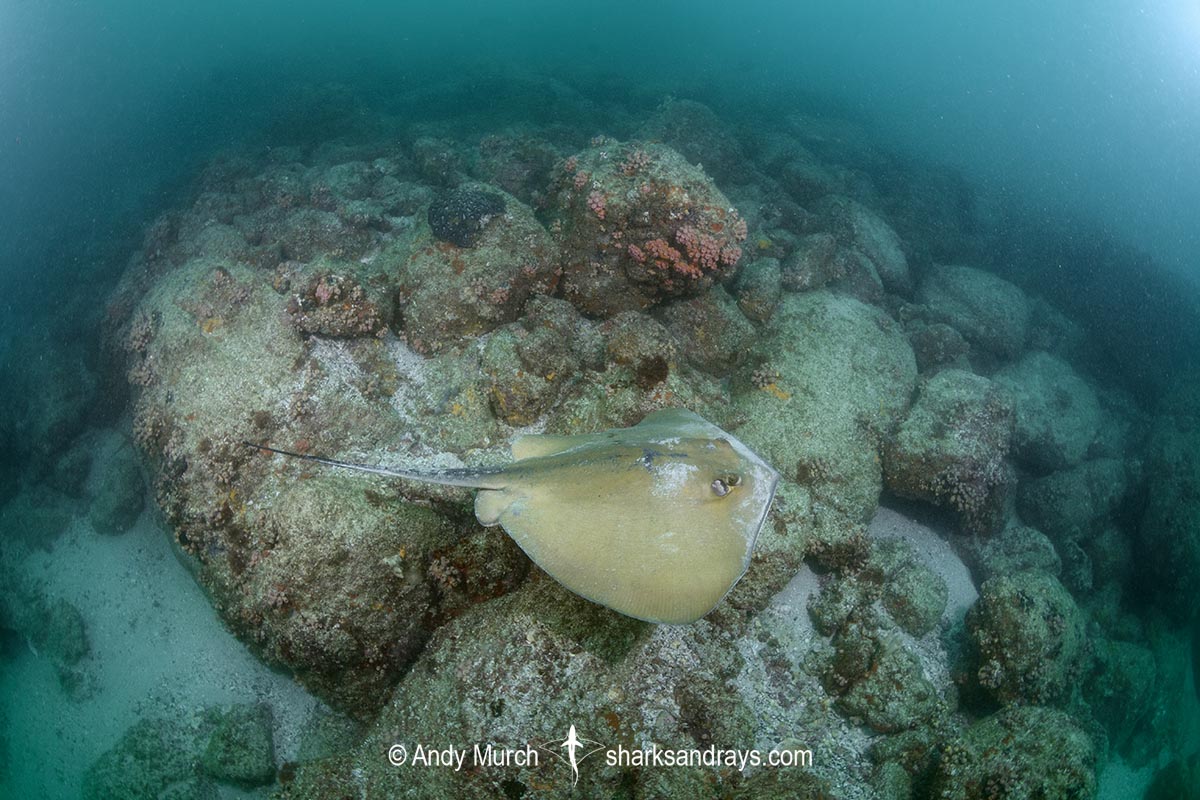Common name(s)
Groovebelly Stingray, Butter Stingray.
Binomial
Dasyatis hypostigma
Synonyms
None
Identification
A medium sized stingray with a kite-shaped disc that is slightly wider than long; disc width approximately 1.0-1.2 x length. Snout obtusely angular with a barely protruding tip. Anterior margins of disc straight or very weakly convex. Pectoral fin apexes narrowly rounded or angular. Pelvic fins small, with broadly rounded apices. Ventrum has a distinct ‘W’ shaped groove posterior to gills
Eyes medium sized and protruding. Snout length ~1.5 x combined eye and spiracle length.
Mouth contains 5-7 oral papillae. Weak labial furrows around mouth. Lower jaw convex with a concavity at symphysis. Small, skirt-shaped, weakly bi-lobed nasal curtain with a strongly fringed margin. Nostrils narrow, positioned obliquely.
Disc lacks dermal denticles. Larger females may have small thorn patches on posterior disc and anterior tail. Tail broad and depressed at base, tapering to tail sting, then filamentous to tip. Tail length quite varied: 1.3-2.3 x disc width. Ventral finfold long and low. Dorsal finfold often deeper than ventral finfold. 1-2 caudal stings present.
Colour
Dorsum uniformly olive brown to golden brown. Midline beyond nape often dusky; darkening on dorsal surface of tail. Tail white/pale laterally. Ventrum white sometimes with dusky blotches in gill region. Tail beyond sting and fin folds dark/black.
Size
Maximum disc width 58cm, possibly larger. Disc width at birth unknown.

Conservation Status
ENDANGERED
The groovebelly stingray is a highly sought-after species, captured in unmonitored artisanal fisheries and commercial trawl and gillnet fisheries throughout its range.
In northern Argentina, it declined in research trawl landings by more than 86% between 1981 and 2006. It is suspected that similar declines have occurred in Brazil.
Dasyatis hypostigma is also affected by habitat degradation due to agriculture, industry, and coastal land conversion around large cities.

Habitat
Tropical to temperate seas. In estuaries and on soft substrates, sometimes adjacent to coral/rocky reefs. Listed as occurring from 5-80m. Usually shallower than 40m. Two seen at night at 1m depth near Buzios, Brazil (personal observation).
Distribution
Southwest Atlantic. From Espírito Santo in Brazil to southern Buenos Aires Province in Argentina
Reproduction
Aplacental viviparity. 2 pups per litter.
Diet
Diet probably consists of benthic invertebrates.
Behavior
Rests on open substrate by day. Moves inshore to feed at night.
Reaction to divers
The groovebelly stingray is generally shy during the day; quickly bolting even if approached slowly. It is much more approachable at night, sometimes allowing divers to follow it as it searches on the sand.
Diving logistics
Groovebelly stingrays are the most common rays seen at dive sites north of Rio De Janiero in August and September; perhaps in other months as well.
At the islands close to Buzios, I found these rays on every dive. During a night dive at Praia Joao Fernandes, I was able to closely approach two groovebelly stingrays foraging in 1m of water.
What’s new
View our full list of updates
Similar species
Lutz’s Stingray Distinguished by generally larger size, small black flecks on dorsum, and a more convex anterior disc margin.
Roughtail Stingray Distinguished by much larger size, line of white spots on pectoral fins, and a more convex anterior disc margin.







